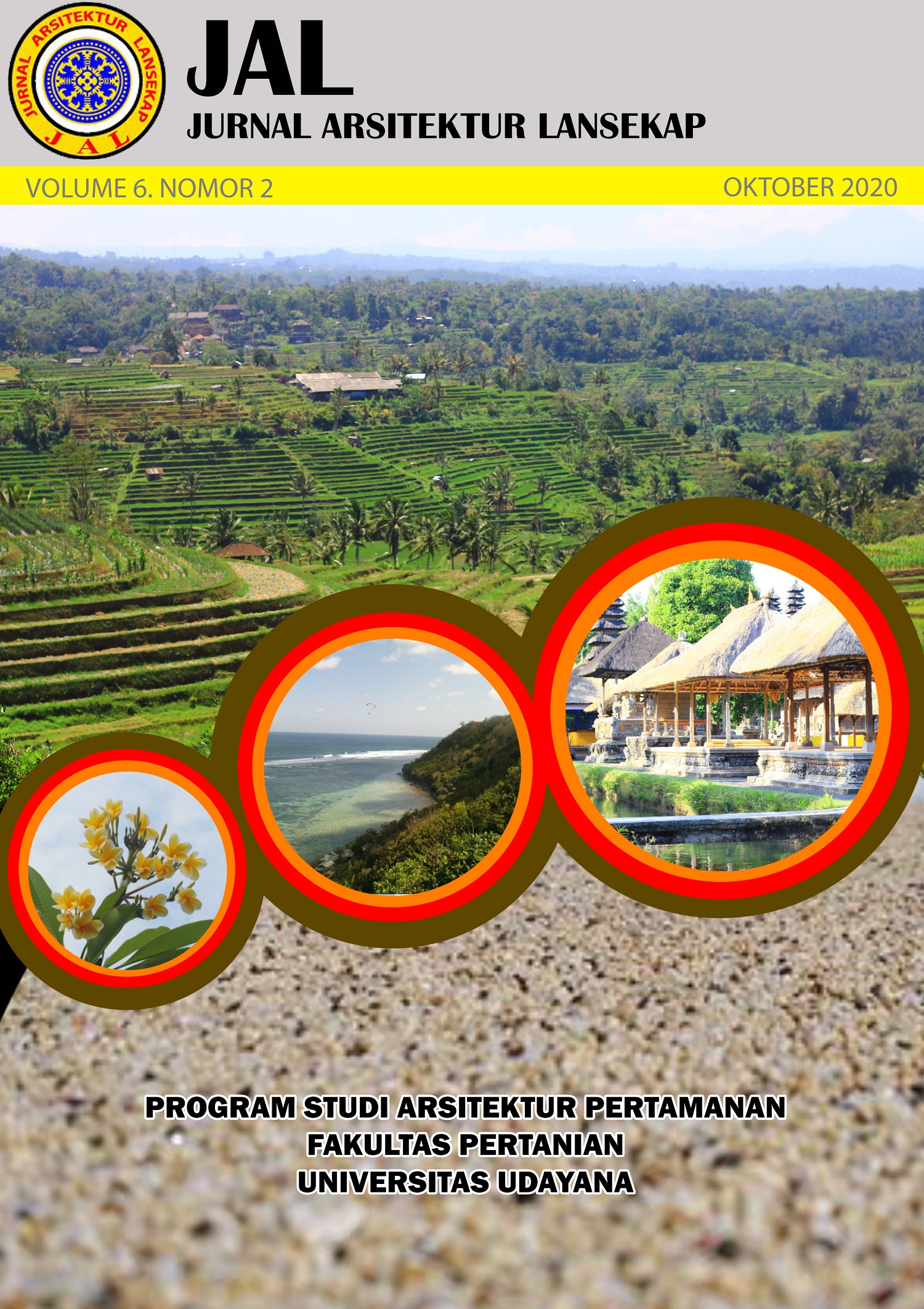Perencanaan hutan kota sebagai pengendali kenyamanan termal (studi kasus: Subak Munduk Gendang, Desa Kesiman Kertalangu, Kecamatan Denpasar Timur, Kota Denpasar, Bali)
Abstract
Urban forest planning as a thermal comfort controller (case study: Subak Munduk Gendang, Kesiman Kertalangu village, East Denpasar district, Denpasar City, Bali). Urban Forest is a land stretching with dense trees growing in urban areas both on state land and public land, in which is appointed as urban forest by government official authority. One function of the urban forest is to ameliorate microclimate in urban areas so that thermal comfort will increase. The aim of this research is to design urban forest as controller of thermal comfort. This research uses the potential analysis method, site constraints method, amenity method, danger signal method, Thermal Humidity Index (THI), vegetation analysis methods, and linear regression methods. The site of this research is divided into three zone, such as extensive zone, semi intensive zone and intensive zone based on the potential and the constraint of biophysical aspects of the site. The result of this research is on the plan of adding tree green space about 20,53% or 15610 m2 of the total area of Subak Munduk Gendang, thereby it is estimated that THI value <27,00 (ideal THI 27,00).
Downloads
References
Heddy, S. (1997). Metode Analisis Vegetasi dan Komunitas. Bogor: Penerbit Institut Pertanian Bogor.
Irwan, Z. D. (1994). Peranan Bentuk dan Struktur Kota terhadap Kualitas Lingkungan Kota. Diakses dari Institut Pertanian Bogor, IPB Repository, http://repository.ipb.ac.id/handle/123456789/2576.
Nurisjah, S. (2015). Hutan Kota Perencanaan Praktis. Jakarta: Ikatan Arsitek Lansekap Indonesia (IALI).
Republik Indonesia. (2002). Peraturan Pemerintah Republik Indonesia Nomor 63 Tahun 2002 Tentang Hutan Kota. Jakarta: Sekretaris Negara Republik Indonesia.
Tauhid., Khadiyanto, P., Hadiyarto, A. (2008). Kajian Jarak Jangkau Efek Vegetasi Pohon Terhadap Suhu Udara Pada Siang Hari di Perkotaan (Studi Kasus: Area Simpang Lima Kota Semarang). Diakses dari Universitas Diponegoro, Institutional Repository (UNDIP-IR), http://eprints.undip.ac.id/17888/.
Zahra, A. F., Sitawati., & Suryanto, A. (2012). Evaluasi Keindahan dan Kenyamanan Ruang Terbuka Hijau (RTH) Alun-Alun Kota Batu. Diakses dari Universitas Brawijaya, Jurnal Produksi Tanaman, http://protan.studentjournal.ub.ac.id/index.php/protan/article/view/140.
Zal, M. A., Nuarsa, I. W., & Utami, N. W. F. (2017). Analisis Korelasi Perubahan Tutupan Vegetasi terhadap Perubahan Suhu Udara di Kota Denpasar. Diakses dari Universitas Udayana, Open Journal Systems UNUD, https://ojs.unud.ac.id/index.php/ECOTROPHIC/article/view/35441.
An author who publishes in the Jurnal Arsitektur Lansekap (JAL) agrees to the following terms:
- Author retains the copyright and grants the journal the right of first publication of the work simultaneously licensed under the Creative Commons Attribution-ShareAlike 4.0 License that allows others to share the work with an acknowledgement of the work's authorship and initial publication in this journal
- Author is able to enter into separate, additional contractual arrangements for the non-exclusive distribution of the journal's published version of the work (e.g., post it to an institutional repository or publish it in a book) with the acknowledgement of its initial publication in this journal.
- Author is permitted and encouraged to post his/her work online (e.g., in institutional repositories or on their website) prior to and during the submission process, as it can lead to productive exchanges, as well as earlier and greater citation of the published work (See The Effect of Open Access).
Read more about the Creative Commons Attribution-ShareAlike 4.0 Licence here: https://creativecommons.org/licenses/by-sa/4.0/.







